Sarah L. Johnson's Blog, page 17
June 1, 2023
Interview with Stephanie Cowell about her new historical novel The Boy in the Rain (and giveaway)
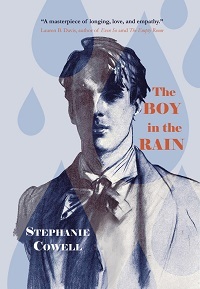 Please help me welcome novelist Stephanie Cowell to the blog. Her newest novel, The Boy in the Rain, focuses on the enduring love affair between two young men in Edwardian-era Nottinghamshire and London: Robbie Stillman, an art student; and Anton Harrington, a banker who later achieves prominence as a socialist speaker. Because of the brutal legal punishment for homosexuality at the time, as well as the social opprobrium, the two must conceal their intimacy from the world.
Please help me welcome novelist Stephanie Cowell to the blog. Her newest novel, The Boy in the Rain, focuses on the enduring love affair between two young men in Edwardian-era Nottinghamshire and London: Robbie Stillman, an art student; and Anton Harrington, a banker who later achieves prominence as a socialist speaker. Because of the brutal legal punishment for homosexuality at the time, as well as the social opprobrium, the two must conceal their intimacy from the world.I've known Stephanie for many years through the Historical Novel Society and am happy to see the novel she's worked on for so long appear in published form at last. It's out from Regal House today.
I'm offering a giveaway at the end of the post since I wanted to give another historical fiction enthusiast the opportunity to read it. I'll be arranging for the novel to be sent directly from a bookseller to the winner's address (via either Amazon or Blackwell's, for non-US readers).
Thanks for Stephanie for doing a Q&A for my site!
How did the complex love story between Robbie and Anton capture you to such a degree, compel you to tell it, and get it out into the world?
The two men came to me in a sort of vision while walking down the outside wood steps of an old country house and haunted me from 1984 until I sold the novel a few years ago. I would put it away for four or five years at a time. I did not know if they came from some deep mystical place inside myself or had really lived in the past.
Reading the novel, and immersing myself in the viewpoints of Robbie and Anton, was such an intense experience. Their relationship, and how it changes over the years, feels so real and vibrant. How did you go about re-creating the worlds of gay men in Edwardian England?
The world they lived in came gradually in bits as I read many social history books of the times. It was the personalities of the two men which fascinated me and how, though their strengths and needs changed, they still felt their real home was with each other. When I was a young teenager, my mother told me about Oscar Wilde’s imprisonment for two years with hard labor, which he had to suffer for loving another man. It made her so angry. But I couldn’t put in much of the danger of the law against homosexuality in the novel at first, because I have always had a difficult time putting my characters in danger.
When I was writing my last big revision, Covid had arrived. I was alone in my apartment in NYC, the world epicenter of the epidemic for a time, hearing all the ambulances rush below my window. Those months, a real sense of danger came into the novel, the feeling that we didn’t know when we too would catch it. I wondered if it was anything like men’s fear of being dragged from their lives. Actually, Robbie likely didn’t have to hide much with his London artistic friends, but Anton had to be very cautious in his world. The boys’ brothel was based on something I had come across in my research.
George Langstaff, the country vicar who takes in and becomes a guiding force for Robbie, quickly became a favorite person of mine. How did his character come about?
I was raised without religion. At the time I began the early drafts of the novel (1984) I was drawn to the Church of England. At the same time, I was working on my novel Nicholas Cooke in which the main character becomes a priest. I joined an Anglican church in NYC. I think Mr. Langstaff’s character is much drawn from the father of a dear friend who was such a guide to me and who, with his wife, took me in to live when I was 18 and had to leave home. His passionate typing and heaps of books and way of walking and being went into creating George. He played the piano clumsily too. The vicar was also drawn from the small English rector in my own church.
Early 20th-century England was a time of huge political and social change. What drew you to this atmosphere for your setting?
The political and social worlds were not in the novel in the early drafts, though the book contained the story of how Anton had been forced by his father to separate from the penniless girl who was bearing his child. A friend who read the novel then said, “I think a guy like Anton would go up to Parliament to try to change laws to help the poor.” I began to revise that way.
I was also compelled by what I read about poverty in England at that time. I think the first book I read was by Jack London, who went to London and lived among the poor in disguise. It’s called People of the Abyss. It was the oddest thing when the Labour and Liberal parties were trying to get a bill passed to help the poor and aged in 1910, that the King, Edward VII, bullied the House of Lords into passing it. And of course, as a character points out in the novel, these high taxes on the wealthy meant that it would be harder to sustain the lives of the country house owners, such as the Crawleys of Downton Abbey. It was awful back then. Ploughmen would live on twelve shillings a week, and no one in their family had anything but bread and tea. And children of five or six would work in factories and mines twelve hours a day.
I enjoy how your historical novels delve into the lives of artists – painters like Robbie, authors, actors, musicians, and more – and the challenges they face in pursuing their craft. What do you hope readers take away from your work about the role of art in people’s lives, and in society?
I don’t think I ever wrote about anyone who was not an artist in some way! That was my world when I grew up. It was inconceivable to be anything but an artist, writer, dancer, actor. And of course, we all faced difficulties in making a living. Louise, Anton’s ex-wife who lives in a lovely London townhouse and knows people with money, helps Robbie to make a living painting portraits. There was a need for that then, following the footsteps of the great artist John Singer Sargent.
It is an oddity in the book that eventually Robbie is painting the wealthy to support Anton’s political campaign whose aim is to tax the wealthy! I guess I would like to show once again how precarious an artistic life can be. It was in my previous books showing how hard Mozart, Monet and Shakespeare struggled. When I was a single mother trying to make a living from music, we had trouble paying basic bills. The phone was shut off several times. Then I’d have to go down to the payment office to charm and distract them into turning it on again or give them a check that I “forgot” to sign!
In your author’s note, you talk about the lengthy writing process behind The Boy in the Rain and how you kept returning to the story in between publishing other novels. I was glad to have the opportunity to read it at last, and that you persevered! Did you have any favorite parts of the writing process, or key moments in the creation that you’d like to share?
I had to persevere because Anton and Robbie and their friends simply would not let me go. The novel kept almost being sold in earlier versions, and then editors would decide they wanted something easier to market, but its long gestation gave me a chance to develop the complex way the men related to each other. In some odd way they are both parts of me.
~
Stephanie Cowell has been an opera singer, balladeer, founder of Strawberry Opera and other arts venues, including a Renaissance festival and an outdoor arts series in NYC. She is the author of Nicholas Cooke, The Physician of London, The Players: A Novel of the Young Shakespeare, Marrying Mozart, and Claude & Camille: A Novel of Monet. Her work had been translated into nine languages and adapted into an opera. Stephanie is the recipient of an American Book Award.
Loading…
Published on June 01, 2023 04:30
May 28, 2023
Gail Tsukiyama's The Brightest Star shines a spotlight on American actress Anna May Wong
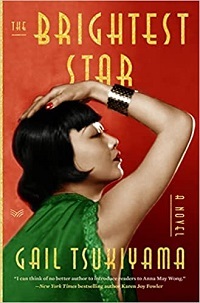 With the recent, long overdue focus on Asian representation in Hollywood, the time is ripe to look back on an industry trailblazer. Following her many previous well-received sagas, Tsukiyama offers a riveting biographical novel about Anna May Wong (1905–61), a third-generation Chinese American whose prominent acting career spanned silent films, early television, and the stage.
With the recent, long overdue focus on Asian representation in Hollywood, the time is ripe to look back on an industry trailblazer. Following her many previous well-received sagas, Tsukiyama offers a riveting biographical novel about Anna May Wong (1905–61), a third-generation Chinese American whose prominent acting career spanned silent films, early television, and the stage. Wong’s intimate voice, in this imagined account, rings so clear that readers may be tempted into believing they’re reading an actual memoir. Growing up amid her parents’ laundry business near Los Angeles’ Chinatown, Anna skips school to visit nickelodeons and vows to appear on screen herself. She achieves remarkable success, always striving to give audiences authentic Chinese portrayals, though is stymied by stereotypical parts, anti-miscegenation laws, and paternal pressure to abandon her “shameful” profession.
For greater freedom, Anna travels to Europe, where she befriends Marlene Dietrich and Josephine Baker. With its rich supporting cast, the novel emphasizes the friendships and family relationships that help Anna thrive, while her many disappointments (like losing a leading role in The Good Earth to a German actress in “yellowface”) catch at the heart.
At times, the narrative breezes rather quickly through Anna’s accomplishments, but overall, this stirring story about the drive and courageous spirit of a talented, barrier-breaking American icon works magnificently.
The Brightest Star will be published by HarperVia on June 20th; I reviewed it for Booklist's historical fiction issue, which came out on May 15th. The review was the magazine's Review of the Day on May 17th.
Wong was recognized with a star on the Hollywood Walk of Fame in 1960, and the U.S. Mint issued a quarter with her image in October 2022; she was the first Asian American to appear on U.S. currency. Hers is a fascinating story of talent and determination that deserves readers' attention. You can view many of her films (and clips from them) at the Gallery of Anna May Wong channel on YouTube.
Published on May 28, 2023 11:28
May 25, 2023
Code Name Sapphire tells a story of family, love, and a daring Holocaust rescue
Pam Jenoff���s newest WWII novel takes its inspiration from an astonishing attempt by Belgian resistance fighters to stop a train heading to Auschwitz and rescue its Jewish occupants from certain death. How did they plan it? What mindset was required of those who risked their lives to undertake such a secretive, dangerous task?
The aspects of how the participants strategize and carry out the passengers��� liberation are the most gripping of the story. By the time we reach this episode, we���ve become familiar with the characters, their relationships, and how desperate choices propelled each of them to act.
Three women���s lives converge in occupied Belgium in 1942. Hannah Martel, a Jewish refugee from Nazi Germany who had secretly drawn and printed subversive political cartoons, disembarks in Antwerp after her Havana-bound ship is turned away in Cuba and forced to return to Europe. Lily Abels, her cousin and once-close friend, whom Hannah hasn���t seen for a decade, willingly shelters her at her comfortable Brussels home. Now married to a doctor and the mother of a ten-year-old son, Lily takes pride in her Belgian citizenship and believes it will ensure her safety.
Having seen her fianc�� killed in a pogrom back home, Hannah knows better, and realizes that her past activities make her a top German target. She needs to flee the country as soon as possible through unofficial channels, and her search leads her to Micheline, the young leader of the Sapphire Line, a clandestine network dedicated to rescuing downed Allied airmen and shepherding them out of Europe via the Pyrenees.
Although the cousins start to regain the close rapport they had in childhood, Hannah���s daring clandestine activities bring danger to Lily���s doorstep. She also grows intrigued by Micheline���s brother, Matteo, who happens to be a man from Lily���s past. All three women are flawed individuals who make mistakes they must quickly recover from: Lily, whose complacency leads her to deny the tragic reality facing all Belgium���s Jews; Hannah, who knowingly risks Lily���s safety; and Micheline, who must root out a mole in the Sapphire network.
Readers who enjoy WWII historical fiction about the resistance have plentiful choices, and the broad-brush characterizations mean this novel doesn't rise above the crowd as much as it could. The love triangle, which relies on coincidences of time and place, also feels unnecessary. The historical framework on which the plot is scaffolded, though, is well worth learning about through the story, which examines how people���s bravery bursts forth when circumstances demand it.
Code Name Sapphire was published by Park Row in February, and I read it from a NetGalley copy.
The aspects of how the participants strategize and carry out the passengers��� liberation are the most gripping of the story. By the time we reach this episode, we���ve become familiar with the characters, their relationships, and how desperate choices propelled each of them to act.
Three women���s lives converge in occupied Belgium in 1942. Hannah Martel, a Jewish refugee from Nazi Germany who had secretly drawn and printed subversive political cartoons, disembarks in Antwerp after her Havana-bound ship is turned away in Cuba and forced to return to Europe. Lily Abels, her cousin and once-close friend, whom Hannah hasn���t seen for a decade, willingly shelters her at her comfortable Brussels home. Now married to a doctor and the mother of a ten-year-old son, Lily takes pride in her Belgian citizenship and believes it will ensure her safety.
Having seen her fianc�� killed in a pogrom back home, Hannah knows better, and realizes that her past activities make her a top German target. She needs to flee the country as soon as possible through unofficial channels, and her search leads her to Micheline, the young leader of the Sapphire Line, a clandestine network dedicated to rescuing downed Allied airmen and shepherding them out of Europe via the Pyrenees.
Although the cousins start to regain the close rapport they had in childhood, Hannah���s daring clandestine activities bring danger to Lily���s doorstep. She also grows intrigued by Micheline���s brother, Matteo, who happens to be a man from Lily���s past. All three women are flawed individuals who make mistakes they must quickly recover from: Lily, whose complacency leads her to deny the tragic reality facing all Belgium���s Jews; Hannah, who knowingly risks Lily���s safety; and Micheline, who must root out a mole in the Sapphire network.
Readers who enjoy WWII historical fiction about the resistance have plentiful choices, and the broad-brush characterizations mean this novel doesn't rise above the crowd as much as it could. The love triangle, which relies on coincidences of time and place, also feels unnecessary. The historical framework on which the plot is scaffolded, though, is well worth learning about through the story, which examines how people���s bravery bursts forth when circumstances demand it.
Code Name Sapphire was published by Park Row in February, and I read it from a NetGalley copy.
Published on May 25, 2023 05:00
May 17, 2023
Good Night, Irene by Luis Alberto Urrea reveals the heroism of WWII's "Donut Dollies"
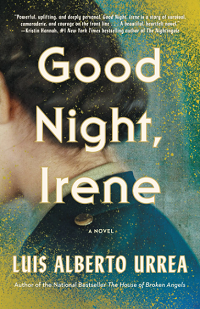 With cinematic authenticity and deep emotional understanding, Urrea opens readers’ eyes to the female Red Cross volunteers who served overseas during WWII by delivering donuts, coffee, and homestyle friendliness to U.S. troops. The author’s mother, herself a minor character, was one of these women, who were nicknamed “Donut Dollies.”
With cinematic authenticity and deep emotional understanding, Urrea opens readers’ eyes to the female Red Cross volunteers who served overseas during WWII by delivering donuts, coffee, and homestyle friendliness to U.S. troops. The author’s mother, herself a minor character, was one of these women, who were nicknamed “Donut Dollies.” Fleeing a violent relationship, gregarious Irene Woodward gets partnered with tall Indiana farmer Dorothy Dunford, cementing a tight bond of sisterhood. Their personalities and the writing itself crackle with energy as Dorothy drives their truck across England and the continent, following orders on where they’re most needed.
The servicemen greatly appreciate their work on the front lines, and the novel’s sense of realism grabs hold as the women become trapped in a French town crawling with Nazis.
War engulfs everyone in its path, as does the mental strain of constant danger, though Irene’s romance with a fighter pilot boosts her inner strength. WWII fiction fans, who have an abundance of options, should embrace this vivid, hard-hitting novel about the valiant achievements of these unsung wartime heroines.
Good Night, Irene will be published by Little, Brown on May 30th; I wrote this review for Booklist. In an interview with Publishers Weekly, the author discusses how character of Irene is based on his mother, Phyllis, and her experiences during the war as a volunteer with the American Red Cross. Dorothy is based on her best friend Jill Pitts Knappenberger. Jill, a resident of Champaign, Illinois, lived until 102 and shared her memories of the war and Phyllis with the author.
Read more in his guest essay for the New York Times, where he discusses piecing together the life story of his mother, and how her service as a Red Cross Clubmobiler (Clubmobiles were the vehicles they drove) has been neglected in the historical record.
See also the article "Clubmobile Gal" at the Warfare History Network for more context as well as photos of Jill, Phyllis, and their American Red Cross Clubmobile, the Cheyenne.
Published on May 17, 2023 16:59
May 13, 2023
Daughters of Nantucket follows three women during the island's Great Fire of 1846 and its aftermath
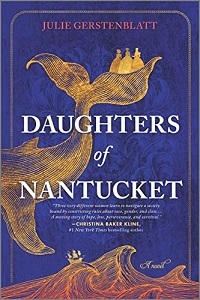 Nantucket’s Great Fire of 1846, a turning point in the life of the island and its residents, was a historical catastrophe that’s relatively little-known today. In her debut, Gerstenblatt tells an emotionally gripping tale from the viewpoints of three determined Nantucket women whose personal stories resonate as strongly as that of the terrible event they live through.
Nantucket’s Great Fire of 1846, a turning point in the life of the island and its residents, was a historical catastrophe that’s relatively little-known today. In her debut, Gerstenblatt tells an emotionally gripping tale from the viewpoints of three determined Nantucket women whose personal stories resonate as strongly as that of the terrible event they live through.Meg Wright and her husband, Benjamin, a free Black couple, anxiously await the birth of their next child while aspiring to move their cobbler shop to a prominent spot on Main Street. Standing in their way is Eliza Macy, a whaling captain’s wife anxious about her family’s finances; her husband Henry’s years-long voyage was extended, the bank won’t approve another loan, and her son-in-law’s business competes with the Wrights’ store.
Eliza’s stance kindles a conflict with friend and neighbor Maria Mitchell, an astronomer and librarian at the Nantucket Atheneum who hides her attraction to another scientifically-minded young woman. Tensions emerging from racial prejudice and clandestine desires are already heating up when the fire breaks out, forcing everyone to choose what’s most valuable to them.
Nantucket stands apart for many reasons: thirty miles from the Massachusetts mainland, it’s grown prosperous through the production of whale oil (“sleeping liquid gold”), and with many husbands absent, the women are self-sufficient by necessity. The island’s widespread Quaker beliefs also grant women equal standing. The social milieu and geographical environment, from the bustling downtown to the Wrights’ multiethnic New Guinea neighborhood, integrate well into the plotline.
Wisely, Gerstenblatt doesn’t force the women into a contrived sisterhood but allows their individual personalities and principles to shine. Seeing the women through each other’s eyes—particularly Eliza, whose self-image contrasts with outsiders’ views—adds new facets to the character portraits. Engaging to the finale (which leaves one plot thread tantalizingly open), this novel would be a great book club choice.
Daughters of Nantucket was published by MIRA in March; I reviewed it from NetGalley for May's Historical Novels Review. Maria Mitchell is a historical figure; the other two protagonists are fictional.
Published on May 13, 2023 12:14
May 10, 2023
Historical fiction award news: Pulitzer, Langum Prize, the Anthonys, and Walter Scott Prizes
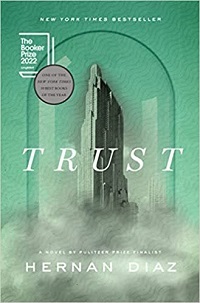 There's quite a bit of news to report about historical novels which recently won or are finalists for literary prizes.
There's quite a bit of news to report about historical novels which recently won or are finalists for literary prizes.Most prominently: the Pulitzer Prize for Fiction was shared (for the first time) by two novels, Trust by Hernan Diaz and Demon Copperhead by Barbara Kingsolver. Trust counts as historical fiction; set in the world of corporate finance in early 20th-century NYC, the story unfolds through four different accounts, and each gets progressively closer to the truth. Read my review here.
Also announced this week was the Langum Prize in American Historical Fiction, which went to Mercury Pictures Presents by Anthony Marra. As the press release notes, it "explores an unusual and carefully researched perspective into World War 2. Split between Hollywood and an Italian prison camp, the novel follows several interconnected lives at the point when America is just about to enter the war and shortly after." The finalist was The Magic Kingdom by Russell Banks, which I reviewed earlier this year.
The shortlist for the 2023 Walter Scott Prize was released in early April, and contains the following:
These Days, Lucy Caldwell, about the Belfast BlitzThe Geometer Lobachevsky, Adrian Duncan Act of Oblivion, Robert Harris The Chosen, Elizabeth Lowry The Sun Walks Down, Fiona McFarlane Ancestry, Simon MawerI Am Not Your Eve, Devika Ponnambalam
See more about all of them on the Goodreads list for the Walter Scott Prize (there's a section further down that page for nominees).
The Harris, McFarlane, and Mawer novels have US editions. For US residents interested in obtaining any of the others (or other British or Aus/NZ titles for that matter), since Book Depository is sadly defunct, Blackwell's also offers free international shipping, as does Fishpond.
The winner will be announced in mid-June.
And the Anthony Award finalists for Best Historical (these have a mystery/crime focus) include:
The Lindbergh Nanny, Mariah Fredericks
Danger on the Atlantic, Erica Ruth NeubauerIn Place of Fear, Catriona McPherson
Under a Veiled Moon, Karen Odden
Anywhere You Run, Wanda M. Morris
Lavender House, Lev A.C. Rosen
See more at the Bouchercon website. Other historicals made the finals for other prizes, including Harini Nagendra's The Bangalore Detectives Club, which is up for Best First Novel.
Published on May 10, 2023 07:30
May 9, 2023
Ballrooms and Butlers: The Grand Estates of the San Francisco Peninsula, an essay by Ginny Kubitz Moyer
Ginny Kubitz Moyer is here with a post about historic country estates and their gardens, the setting for her new release
The Seeing Garden
, which is published today. The gorgeous photos are from her research visits.
~
Ballrooms and Butlers: The Grand Estates of the
San Francisco PeninsulaGinny Kubitz Moyer
I’ve always had a fondness for stories set in big country estates. Whether it was The Secret Garden as a child or Rebecca as a teenager or Downton Abbey as an adult, the idea of the grand house has always captivated me. As a native Californian, though, I always thought these stories happened in other places. The world of butlers and ballrooms never existed anywhere near my home in Silicon Valley, did it?
Actually, it did.
In the late nineteenth and early twentieth centuries, the San Francisco Peninsula was home to dozens of lavish country estates. San Franciscans who made their money in mining, banking, utilities, or the railroad—or who inherited fortunes from fathers who had—found that a leisurely country lifestyle could be theirs in the rolling hills of the Peninsula. The infamous fog of San Francisco dissipates as one moves south, making the area even more enticing, and good railroad links ensured an easy commute back to offices in the city. These factors led to the proliferation of estates throughout present San Mateo County, on land that was previously inhabited by Mexican rancheros and, prior to that, by the Ohlone people.
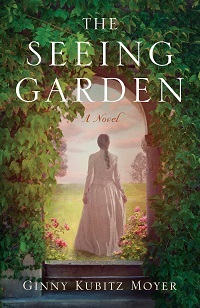 Today, entering the world of these estates takes a fair amount of imagination. In researching The Seeing Garden, I marveled at how much the Peninsula has changed in one hundred and fifty years. Although some of the mansions still exist as private residences, many of the biggest estates were razed long ago to make way for housing or businesses. In the city of San Mateo, for example, the site of the estate owned by businessman Antoine Borel is now primarily shops and office buildings. There’s no trace of his large house or the pond and rocky walls that were built to look like the mountain passes of Borel’s native Switzerland.
Today, entering the world of these estates takes a fair amount of imagination. In researching The Seeing Garden, I marveled at how much the Peninsula has changed in one hundred and fifty years. Although some of the mansions still exist as private residences, many of the biggest estates were razed long ago to make way for housing or businesses. In the city of San Mateo, for example, the site of the estate owned by businessman Antoine Borel is now primarily shops and office buildings. There’s no trace of his large house or the pond and rocky walls that were built to look like the mountain passes of Borel’s native Switzerland.
One and a half miles north, a high-rise apartment building dominates the skyline at what was once the El Cerrito estate, the oldest one on the Peninsula. At the time of The Seeing Garden (1910), El Cerrito was owned by Eugene de Sabla, Jr., co-founder of Pacific Gas & Electric Company. Although the estate was eventually sold and subdivided, one lovely piece that remains is the Japanese garden commissioned by De Sabla. Designed by Makoto Hagiwara (who also designed the Japanese Tea Garden in Golden Gate Park), the garden is now part of a private residence on a suburban street. A plaque on the site notes that it is listed in the National Register of Historic Places, and its serene beauty can be glimpsed through the gates along the street.
 Gates to the Japanese garden,
Gates to the Japanese garden,
formerly part of the El Cerrito estate
In the nearby city of Belmont, Ralston Hall is a sleeping beauty of a mansion on the grounds of Notre Dame de Namur University. Once upon a time, it was the home of William Ralston, founder of the Bank of California. After Ralston’s death by drowning in San Francisco Bay in 1875, the house changed owners and at one point even served as a sanitarium. Now owned by the university, for many years it was available for event rentals. Sadly, it’s now closed, awaiting a fairy godmother philanthropist who can cover the cost of necessary seismic retrofits. Walking around the grounds offers a tantalizing glimpse of the mansion that counted Mark Twain among its guests.
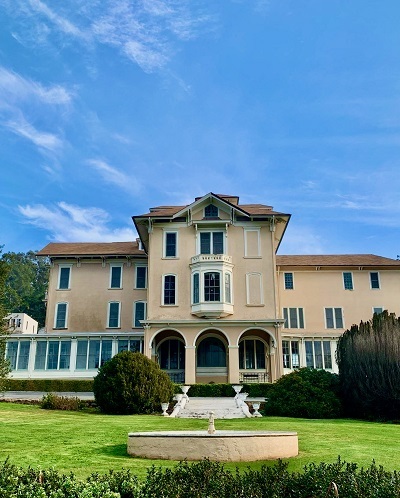 Ralston Hall, the sleeping beauty
Ralston Hall, the sleeping beauty
Today, the most accessible of the estates is Filoli in Woodside. It was completed in 1917 for William and Agnes Bourn, and is now open to the public, inviting visitors to walk through the airy Georgian Revival house and savor the well-tended gardens. I was in my twenties when I first visited Filoli, on a spring day when the wisteria was in full bloom, and it felt like stepping into one of the novels I loved. That visit planted the seed which eventually turned into Oakview, the fictional estate in The Seeing Garden. While writing the novel, I visited the Filoli gardens often to see what would be blooming in different months. I’ve had few research experiences more enjoyable than that.
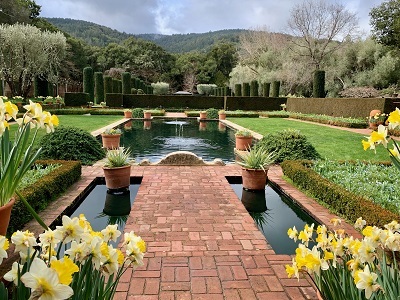 The Filoli Gardens
The Filoli Gardens
Of course, it’s all too easy to focus on those who owned the big houses. In reality, the estates were kept afloat by fleets of gardeners, maids, butlers, housekeepers, and other employees. The kitchen at Filoli offers a display of census reports, showing the staggering number of people who worked there. Each estate was a microcosm of the larger society; class divisions were inescapable and much was owned by very few. Arguably, little has changed.
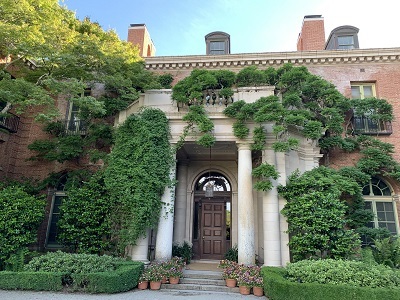 The Filoli mansion, Woodside, California
The Filoli mansion, Woodside, California
But one of the joys of writing historical fiction is its sense of possibility. Imagination is free, research frequently is, and anyone who is inspired by a certain period can travel back in time through the act of storytelling. As I wrote The Seeing Garden, the Peninsula of the great estates was a captivating place to call home.
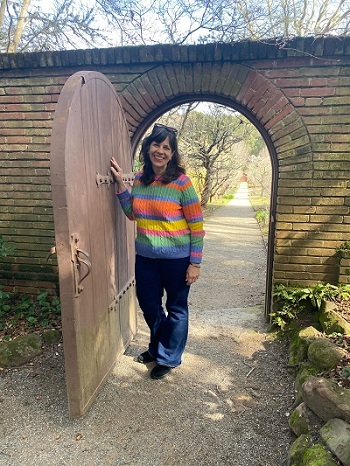 the author in the Filoli Gardens
the author in the Filoli Gardens
~
Ginny Kubitz Moyer is a California native with a love of local history. A graduate of Pomona College and Stanford University, she is the author of the new novel The Seeing Garden (She Writes Press). An avid weekend gardener, she lives in the San Francisco Bay Area with her husband, two sons, and one rescue dog. You can learn more about her at ginnymoyer.org.
~
Ballrooms and Butlers: The Grand Estates of the
San Francisco PeninsulaGinny Kubitz Moyer
I’ve always had a fondness for stories set in big country estates. Whether it was The Secret Garden as a child or Rebecca as a teenager or Downton Abbey as an adult, the idea of the grand house has always captivated me. As a native Californian, though, I always thought these stories happened in other places. The world of butlers and ballrooms never existed anywhere near my home in Silicon Valley, did it?
Actually, it did.
In the late nineteenth and early twentieth centuries, the San Francisco Peninsula was home to dozens of lavish country estates. San Franciscans who made their money in mining, banking, utilities, or the railroad—or who inherited fortunes from fathers who had—found that a leisurely country lifestyle could be theirs in the rolling hills of the Peninsula. The infamous fog of San Francisco dissipates as one moves south, making the area even more enticing, and good railroad links ensured an easy commute back to offices in the city. These factors led to the proliferation of estates throughout present San Mateo County, on land that was previously inhabited by Mexican rancheros and, prior to that, by the Ohlone people.
 Today, entering the world of these estates takes a fair amount of imagination. In researching The Seeing Garden, I marveled at how much the Peninsula has changed in one hundred and fifty years. Although some of the mansions still exist as private residences, many of the biggest estates were razed long ago to make way for housing or businesses. In the city of San Mateo, for example, the site of the estate owned by businessman Antoine Borel is now primarily shops and office buildings. There’s no trace of his large house or the pond and rocky walls that were built to look like the mountain passes of Borel’s native Switzerland.
Today, entering the world of these estates takes a fair amount of imagination. In researching The Seeing Garden, I marveled at how much the Peninsula has changed in one hundred and fifty years. Although some of the mansions still exist as private residences, many of the biggest estates were razed long ago to make way for housing or businesses. In the city of San Mateo, for example, the site of the estate owned by businessman Antoine Borel is now primarily shops and office buildings. There’s no trace of his large house or the pond and rocky walls that were built to look like the mountain passes of Borel’s native Switzerland.One and a half miles north, a high-rise apartment building dominates the skyline at what was once the El Cerrito estate, the oldest one on the Peninsula. At the time of The Seeing Garden (1910), El Cerrito was owned by Eugene de Sabla, Jr., co-founder of Pacific Gas & Electric Company. Although the estate was eventually sold and subdivided, one lovely piece that remains is the Japanese garden commissioned by De Sabla. Designed by Makoto Hagiwara (who also designed the Japanese Tea Garden in Golden Gate Park), the garden is now part of a private residence on a suburban street. A plaque on the site notes that it is listed in the National Register of Historic Places, and its serene beauty can be glimpsed through the gates along the street.
 Gates to the Japanese garden,
Gates to the Japanese garden, formerly part of the El Cerrito estate
In the nearby city of Belmont, Ralston Hall is a sleeping beauty of a mansion on the grounds of Notre Dame de Namur University. Once upon a time, it was the home of William Ralston, founder of the Bank of California. After Ralston’s death by drowning in San Francisco Bay in 1875, the house changed owners and at one point even served as a sanitarium. Now owned by the university, for many years it was available for event rentals. Sadly, it’s now closed, awaiting a fairy godmother philanthropist who can cover the cost of necessary seismic retrofits. Walking around the grounds offers a tantalizing glimpse of the mansion that counted Mark Twain among its guests.
 Ralston Hall, the sleeping beauty
Ralston Hall, the sleeping beautyToday, the most accessible of the estates is Filoli in Woodside. It was completed in 1917 for William and Agnes Bourn, and is now open to the public, inviting visitors to walk through the airy Georgian Revival house and savor the well-tended gardens. I was in my twenties when I first visited Filoli, on a spring day when the wisteria was in full bloom, and it felt like stepping into one of the novels I loved. That visit planted the seed which eventually turned into Oakview, the fictional estate in The Seeing Garden. While writing the novel, I visited the Filoli gardens often to see what would be blooming in different months. I’ve had few research experiences more enjoyable than that.
 The Filoli Gardens
The Filoli GardensOf course, it’s all too easy to focus on those who owned the big houses. In reality, the estates were kept afloat by fleets of gardeners, maids, butlers, housekeepers, and other employees. The kitchen at Filoli offers a display of census reports, showing the staggering number of people who worked there. Each estate was a microcosm of the larger society; class divisions were inescapable and much was owned by very few. Arguably, little has changed.
 The Filoli mansion, Woodside, California
The Filoli mansion, Woodside, CaliforniaBut one of the joys of writing historical fiction is its sense of possibility. Imagination is free, research frequently is, and anyone who is inspired by a certain period can travel back in time through the act of storytelling. As I wrote The Seeing Garden, the Peninsula of the great estates was a captivating place to call home.
 the author in the Filoli Gardens
the author in the Filoli Gardens~
Ginny Kubitz Moyer is a California native with a love of local history. A graduate of Pomona College and Stanford University, she is the author of the new novel The Seeing Garden (She Writes Press). An avid weekend gardener, she lives in the San Francisco Bay Area with her husband, two sons, and one rescue dog. You can learn more about her at ginnymoyer.org.
Published on May 09, 2023 04:00
May 4, 2023
Review of Kate Morton's Homecoming, her latest intricate, multi-stranded generational mystery
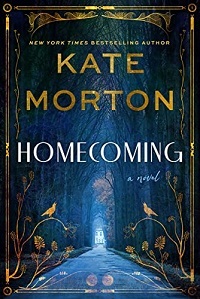 Large old houses, families haunted by history, and suspenseful multi-stranded plots that reveal shocking truths: these are Kate Morton hallmarks, and nobody writes them better. What’s notable here is how she blends these familiar ingredients into an epic page-turner that offers surprises even for longtime fans.
Large old houses, families haunted by history, and suspenseful multi-stranded plots that reveal shocking truths: these are Kate Morton hallmarks, and nobody writes them better. What’s notable here is how she blends these familiar ingredients into an epic page-turner that offers surprises even for longtime fans.In 2018, London-based journalist Jess Turner-Bridges flies back to Sydney after learning that her sharp-witted grandmother Nora, who raised her after her mother left, fell from her attic stairs. Nora’s half-conscious mutterings, combined with her own distant childhood memories, prompt Jess to revisit the past.
She’s stunned to uncover accounts of a terrible crime from 1959 in a small town in South Australia’s Adelaide Hills, when Isabel Turner and her three oldest children went out for a picnic on Christmas Eve on their idyllic Georgian-style estate and were found dead hours later by a deliveryman. Baby Thea, Isabel’s youngest, had vanished from the scene. The unsolved mystery was explored in a bestselling true-crime account published in America, but Nora had never breathed a word about it or her own connection to it.
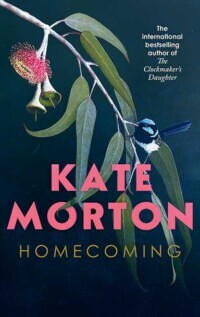
The breathtakingly intricate narrative, which intercuts two eras, unfolds from a multiplicity of viewpoints. Throughout this lengthy tale, Morton maintains a tension that has readers weighing potential clues in every line, but she’s always one step ahead with new twists and possibilities. The book-within-a-book device, which circles through Isabel’s eventful final day and the subsequent police inquiry, is masterfully structured and raises even more questions for Jess.
Settings are firmly anchored and contrasted: the promise of postwar new beginnings, the pressures of family life, and the beautiful, wild landscape of rural South Australia, overlaid by ancient secrets and dark tragedy. Along the way, Morton probes mother-child relationships from various angles and examines the power of story itself. This novel is utterly transporting.
Homecoming was published in April by Mariner in the US, and I reviewed it from NetGalley for May's Historical Novels Review. This is Kate Morton's seventh novel; I've read them all, and it's probably my second favorite, after The Distant Hours. The US cover is at the top, the Australian one further down. Read more about how her own life influenced the Australian setting of the book in a New York Times profile.
Published on May 04, 2023 15:44
April 30, 2023
A short trip to the Holy Island of Lindisfarne in the early 18th century
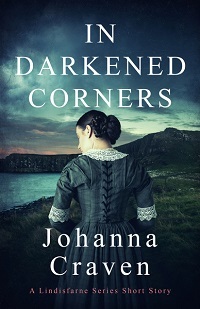 There’s a strange magic to Holy Island, to Lindisfarne; a strange magic that sustains her. (quote from In Darkened Corners)
There’s a strange magic to Holy Island, to Lindisfarne; a strange magic that sustains her. (quote from In Darkened Corners)In 2014, as part of a driving trip from London up to Northumberland and back, my husband I spent a day on Lindisfarne, an island off England’s northeast coast which is accessible by causeway from the mainland at low tide. We visited the ruins of Lindisfarne Priory, the site of an ancient monastery attacked by Vikings in the late 8th century, as well as the 16th-century castle.
It's a place steeped in historic atmosphere. We did a lot of walking and looking out at the sea, and we’ve always wanted to go back. In the photo below, you can see Bamburgh Castle in the distance: another landmark perched at the edge of the water, further down the coastline.
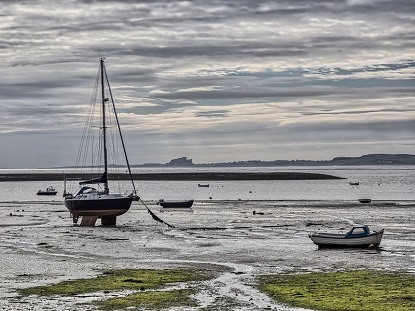 On Lindisfarne, looking out to Bamburgh Castle in center
On Lindisfarne, looking out to Bamburgh Castle in center (Photo by Mark Johnson, 2014)
So when I read about Johanna Craven’s new historical fiction series set on Holy Island, as it’s called, I knew I had to read it, and the author recently offered a prequel short story, In Darkened Corners, as a free download. I read it in between longer novels.
Lindisfarne’s proximity to Scotland is important in the story, which takes place just prior to the 1715 Jacobite Rebellion. Julia Mitchell (her surname isn’t mentioned until halfway through) runs a curiosity shop on Lindisfarne while raising her young son, Bobby, the product of a brief liaison with a Scotsman. Her father had disowned her after discovering her pregnancy, but Julia has made ends meet with her brothers’ support, by selling unusual vintage items, and by taking in a lodger. But when her three brothers reach a political tipping point – now that there’s a German-born monarch on the English throne – and leave the island to join the Jacobite cause, Julia refuses to get involved. Events quickly make it clear to her, however, that she may not have a choice.
The author packs considerable character development and setting details into this shorter format, evoking the sounds of the sea, the majestic patterns of light and shadow in the sky, and the overwhelming sense of remoteness. The deliberate pacing and secretive atmosphere add to the sense of foreboding. One caveat: when Julia finds herself in uncomfortable circumstances, she doesn’t put up much resistance. The situation resolves too quickly, and I would have liked more explanation.
 Lindisfarne Castle (photo by Mark Johnson, 2014)
Lindisfarne Castle (photo by Mark Johnson, 2014)During the story, Julia comes across Highfield House, the abandoned home of the wealthy Blake family, gone now for twenty years. According to the blurb for Firelight Rising, the first full-length book in the series, which comes out in June, the Blakes return to Holy Island and get caught up in new conflicts. I have the book preordered and hope to see Julia again there too, if only as a secondary character.
You can download In Darkened Corners for free via the author’s website (PDF) or via BookFunnel (various other formats). Both books have beautifully designed covers, too.
Published on April 30, 2023 06:58
April 25, 2023
Writing and researching a novel inspired by Irish family history, a guest post by Marian O'Shea Wernicke
Please join me in welcoming novelist Marian O'Shea Wernicke, who has a guest post about the research (including travel!) necessary for her to create her newest work of historical fiction, Out of Ireland, which is published today.
~
Writing and researching a novel inspired by
Irish family historyMarian O'Shea Wernicke
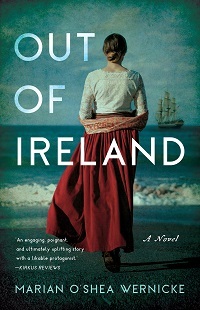 Authors of historical fiction usually enjoy doing the research for their novels. After all, one is reading about a place and time she has never seen or experienced and is not writing yet! So authors may spend months, even years, reading history, novels, examining photos, newsreels, if possible, looking at films set in the period until they feel they have a grasp of the time period as well as the setting.
Authors of historical fiction usually enjoy doing the research for their novels. After all, one is reading about a place and time she has never seen or experienced and is not writing yet! So authors may spend months, even years, reading history, novels, examining photos, newsreels, if possible, looking at films set in the period until they feel they have a grasp of the time period as well as the setting.
But research shows that readers do not read historical fiction to learn history; they read to be entertained! A second reason they read is to be immersed into a time and place not their own by means of a story. So the trick for the writer is to weave the knowledge gained by research ever so delicately into the fabric of the story one is telling.
When I set out to write a novel inspired by the few facts I knew of my great-grandmother, Ellen Hickey Sullivan Jewett, an Irish immigrant born around 1850 in Bantry, Ireland, and who died in St. Louis, Missouri, in 1933, I realized quickly that I had to do a ton of research before I could even begin to tell the story. My most important source of knowledge about her early life in Ireland came from two letters exchanged between her daughters, my grandmother and her sister, my great aunt.
 Photo of the author's great-grandfather
Photo of the author's great-grandfather
Written when they were in their 80s, the letters revealed what my grandmother remembered “about Mama’s life in Ireland.” She said she thought her mother had been born in Bantry, near the sea, that at times they had only fish and black bread to eat, that she had been forced to marry an older man she did not know or love, that they’d had a child and decided to emigrate to America. Even closer to me, my mother had known her, this Irish grandmother who’d lived with them until she died at the age of 87 when my mother was thirteen, and my mother told me stories of jumping into bed with her grandmother during fierce thunderstorms when she was a child. Her grandmother was her best friend as she was growing up in a house full of older brothers. Her real name was Ellen, but in the novel she is Eileen.
My next area of research was life in Bantry, Ireland, in the late 1860s. I am fairly well-versed in Irish literature and history, but now I began serious research into the Irish struggle for independence from the British at that time and place. My second main character is Eileen’s brother Michael, who would be involved in the Irish Republican Brotherhood, an outlawed group of Irish dedicated to the overthrow of British rule in Ireland. I decided I needed to go to Bantry, so in June of 2017 my husband and I flew to Shannon Airport, rented a car, and drove the winding, lonely road south to Bantry, where we had splurged and booked ourselves into two nights at Bantry House, the ancestral home of the Earls of Bantry.
 Bantry House, seat of the Earls of Bantry
Bantry House, seat of the Earls of Bantry
Our stay there gave me the idea of having Eileen’s family, poor Irish Catholics who were forbidden to vote or attend a university, working on such a grand estate both in the fields as tenant farmers and in the house itself as a servant. As the guide showed us the beautiful house and explained its long history, I was imagining Eileen in such a house as a maid. Later we explored the lovely small town, and I could see Eileen being baptized and married at St. Finbarr’s Catholic Church.
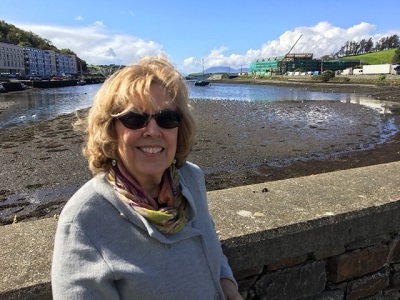 Doing research at mouth of Bantry Bay
Doing research at mouth of Bantry Bay
Next I had to study the whole process of immigration in 1870 as many Irish were fleeing poverty and lack of opportunity in Ireland for America. People left from what is today Cobh although at the time under the British it was called Queenstown, and my characters would make the voyage on a steamship which also would have sails. I scoured the internet for the price of tickets, the supplies the steerage passengers were asked to bring, for the conditions in steerage versus in salon class on these ships, and the diseases rampant in such close quarters. I also read Joseph O’Connor’s powerful novel Star of the Sea for a wonderful fictional treatment of life at sea for immigrants. Drawings of the time, often in newspapers, were another important resource in picturing anguished scenes at the docks as families left, usually forever, all that they knew and loved for a murky future in America or Canada.
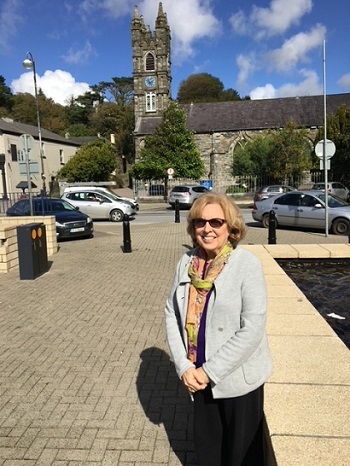 In Bantry town facing St. Brendan’s Church
In Bantry town facing St. Brendan’s Church
In my novel, Eileen and her husband land in Holyoke, Massachusetts, after a brief stop in Manhattan. I had lived and taught high school in Holyoke, so I was familiar with its history of Irish immigrants, many of whom worked in the mills along the river. In poking around the visitor center there on another research trip, I discovered a newspaper story of a terrible accident at a dam there and was able to use this as an important plot point.
Finally my research led to St. Louis, Missouri, my hometown, and the actual place my great-grandmother and one of her brothers ended up. My research there was most surprising. I had never heard of the Irish gangs active in the city in the late 1800s and early 1900s. Some of these gangs justified their illegal activities with the claim that they were raising money to send to the rebels in Ireland who were gearing up to fight for their freedom. In the novel, Michael is involved in one such gang, so I read several accounts such as Paddy Whacked: The Untold Story of the Irish-American Gangster for background. I examined maps of the city in the 1870s, and even found and photographed the house on St. Louis Avenue in North St. Louis where my grandmother was born. It is battered and worn, but it is still standing 139 years later!
After at least three years of research which I greatly enjoyed, it was time to start writing. Now I had the much harder task of weaving just enough of what I had learned into a story of young people that would entertain readers today as well as immerse them in a place and time they would never know except in the pages of a story.
Author Bio
Born and raised in an Irish Catholic family in St. Louis, Missouri, Marian O’Shea Wernicke is the author of the novel Toward That Which Is Beautiful, a finalist in both Literary Fiction and Romance Fiction in the 2021 Independent Book Awards, and a finalist in Multi-Cultural Fiction in the 2021 American Book Awards. The Catholic Press Association awarded the novel Honorable Mention in Fiction in 2021. She is also the author of a memoir about her father, called Tom O’Shea: A Twentieth Century Man.
A nun for eleven years, Wernicke worked in Lima, Peru for three years. After leaving the convent, Wernicke taught English as a Second Language in Madrid, and later became a professor of English and Creative Writing at Pensacola Junior College. Marian married Michael Wernicke, and they are the parents of three children. After living in Pensacola for many years, the couple moved to Austin, Texas, to be near their children and grandson. Michael died this past December, but he lives on in their children and grandchildren.
Website: www.marianosheawernicke.com
~
Writing and researching a novel inspired by
Irish family historyMarian O'Shea Wernicke
 Authors of historical fiction usually enjoy doing the research for their novels. After all, one is reading about a place and time she has never seen or experienced and is not writing yet! So authors may spend months, even years, reading history, novels, examining photos, newsreels, if possible, looking at films set in the period until they feel they have a grasp of the time period as well as the setting.
Authors of historical fiction usually enjoy doing the research for their novels. After all, one is reading about a place and time she has never seen or experienced and is not writing yet! So authors may spend months, even years, reading history, novels, examining photos, newsreels, if possible, looking at films set in the period until they feel they have a grasp of the time period as well as the setting. But research shows that readers do not read historical fiction to learn history; they read to be entertained! A second reason they read is to be immersed into a time and place not their own by means of a story. So the trick for the writer is to weave the knowledge gained by research ever so delicately into the fabric of the story one is telling.
When I set out to write a novel inspired by the few facts I knew of my great-grandmother, Ellen Hickey Sullivan Jewett, an Irish immigrant born around 1850 in Bantry, Ireland, and who died in St. Louis, Missouri, in 1933, I realized quickly that I had to do a ton of research before I could even begin to tell the story. My most important source of knowledge about her early life in Ireland came from two letters exchanged between her daughters, my grandmother and her sister, my great aunt.
 Photo of the author's great-grandfather
Photo of the author's great-grandfatherWritten when they were in their 80s, the letters revealed what my grandmother remembered “about Mama’s life in Ireland.” She said she thought her mother had been born in Bantry, near the sea, that at times they had only fish and black bread to eat, that she had been forced to marry an older man she did not know or love, that they’d had a child and decided to emigrate to America. Even closer to me, my mother had known her, this Irish grandmother who’d lived with them until she died at the age of 87 when my mother was thirteen, and my mother told me stories of jumping into bed with her grandmother during fierce thunderstorms when she was a child. Her grandmother was her best friend as she was growing up in a house full of older brothers. Her real name was Ellen, but in the novel she is Eileen.
My next area of research was life in Bantry, Ireland, in the late 1860s. I am fairly well-versed in Irish literature and history, but now I began serious research into the Irish struggle for independence from the British at that time and place. My second main character is Eileen’s brother Michael, who would be involved in the Irish Republican Brotherhood, an outlawed group of Irish dedicated to the overthrow of British rule in Ireland. I decided I needed to go to Bantry, so in June of 2017 my husband and I flew to Shannon Airport, rented a car, and drove the winding, lonely road south to Bantry, where we had splurged and booked ourselves into two nights at Bantry House, the ancestral home of the Earls of Bantry.
 Bantry House, seat of the Earls of Bantry
Bantry House, seat of the Earls of BantryOur stay there gave me the idea of having Eileen’s family, poor Irish Catholics who were forbidden to vote or attend a university, working on such a grand estate both in the fields as tenant farmers and in the house itself as a servant. As the guide showed us the beautiful house and explained its long history, I was imagining Eileen in such a house as a maid. Later we explored the lovely small town, and I could see Eileen being baptized and married at St. Finbarr’s Catholic Church.
 Doing research at mouth of Bantry Bay
Doing research at mouth of Bantry BayNext I had to study the whole process of immigration in 1870 as many Irish were fleeing poverty and lack of opportunity in Ireland for America. People left from what is today Cobh although at the time under the British it was called Queenstown, and my characters would make the voyage on a steamship which also would have sails. I scoured the internet for the price of tickets, the supplies the steerage passengers were asked to bring, for the conditions in steerage versus in salon class on these ships, and the diseases rampant in such close quarters. I also read Joseph O’Connor’s powerful novel Star of the Sea for a wonderful fictional treatment of life at sea for immigrants. Drawings of the time, often in newspapers, were another important resource in picturing anguished scenes at the docks as families left, usually forever, all that they knew and loved for a murky future in America or Canada.
 In Bantry town facing St. Brendan’s Church
In Bantry town facing St. Brendan’s ChurchIn my novel, Eileen and her husband land in Holyoke, Massachusetts, after a brief stop in Manhattan. I had lived and taught high school in Holyoke, so I was familiar with its history of Irish immigrants, many of whom worked in the mills along the river. In poking around the visitor center there on another research trip, I discovered a newspaper story of a terrible accident at a dam there and was able to use this as an important plot point.
Finally my research led to St. Louis, Missouri, my hometown, and the actual place my great-grandmother and one of her brothers ended up. My research there was most surprising. I had never heard of the Irish gangs active in the city in the late 1800s and early 1900s. Some of these gangs justified their illegal activities with the claim that they were raising money to send to the rebels in Ireland who were gearing up to fight for their freedom. In the novel, Michael is involved in one such gang, so I read several accounts such as Paddy Whacked: The Untold Story of the Irish-American Gangster for background. I examined maps of the city in the 1870s, and even found and photographed the house on St. Louis Avenue in North St. Louis where my grandmother was born. It is battered and worn, but it is still standing 139 years later!
After at least three years of research which I greatly enjoyed, it was time to start writing. Now I had the much harder task of weaving just enough of what I had learned into a story of young people that would entertain readers today as well as immerse them in a place and time they would never know except in the pages of a story.
Author Bio
Born and raised in an Irish Catholic family in St. Louis, Missouri, Marian O’Shea Wernicke is the author of the novel Toward That Which Is Beautiful, a finalist in both Literary Fiction and Romance Fiction in the 2021 Independent Book Awards, and a finalist in Multi-Cultural Fiction in the 2021 American Book Awards. The Catholic Press Association awarded the novel Honorable Mention in Fiction in 2021. She is also the author of a memoir about her father, called Tom O’Shea: A Twentieth Century Man.
A nun for eleven years, Wernicke worked in Lima, Peru for three years. After leaving the convent, Wernicke taught English as a Second Language in Madrid, and later became a professor of English and Creative Writing at Pensacola Junior College. Marian married Michael Wernicke, and they are the parents of three children. After living in Pensacola for many years, the couple moved to Austin, Texas, to be near their children and grandson. Michael died this past December, but he lives on in their children and grandchildren.
Website: www.marianosheawernicke.com
Published on April 25, 2023 05:00



